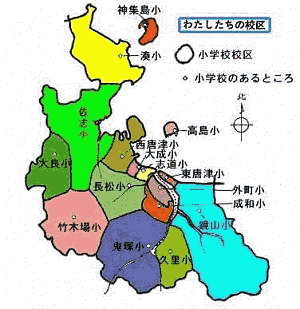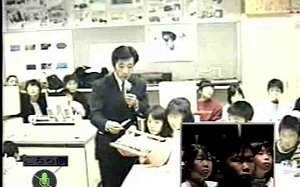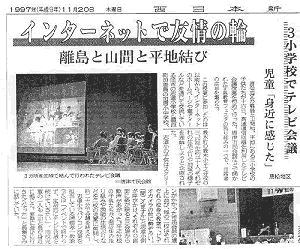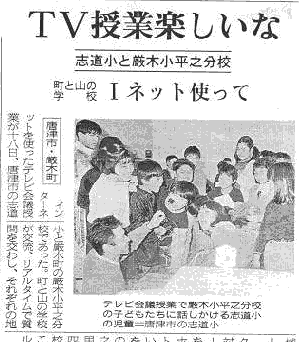Conference to introduce results from the 100-School Networking Project (Phase
II)
Elementary school meeting
A Lesson using Teleconferencing to Communicate with other Children
Koichi Urasato, Shido Elementary School
1. Introduction
 With support
from the CEC, we are preparing for a full-scale joint study using teleconferencing
to establish a network and to develop teaching materials on Japan's various
regions. With help from the city school board, we have rented teleconferencing
equipment and installed an ISDN line.
With support
from the CEC, we are preparing for a full-scale joint study using teleconferencing
to establish a network and to develop teaching materials on Japan's various
regions. With help from the city school board, we have rented teleconferencing
equipment and installed an ISDN line.
It's been four years since our school received computers, and a year and a
half since communication equipment was installed. During this time, we've
used this equipment for education, and to improve computer literacy among
our children.
When elementary and junior high schools in Karatsu city received communication
equipment, members of groups discussing subject curriculum and preparing materials
created home pages for each school, and a home page for "Our Karatsu
City," in which information from each school and area are gathered and
linked. We run this home page as a network in our area, while planning and
examining lessons in which children can do their own research, exchange information
with children in other schools, and generally find more effective and profound
ways to study.
- 1) Create a home page. Collect data that can be used for research, view
home pages of other city elementary schools, and collect information.
2) Exchange e-mail. Answer children's questions on the lesson and exchange
them with other schools, along with other information. Use the Internet to
ask questions and make proposals to the city government.
3) Acquire and use information that can be used for teaching materials. Acquire
information from home pages for social studies and science classes, and use
to create teaching materials (HTML materials.)
4) Correspond with other schools, using a teleconferencing system. Use the
network for research in our social studies classes. Participate in Chicago's
Japan Fiesta.
5) Trial of a simultaneous lesson based on information about our city, using
an ISDN line, with support from the 100-School Networking Project.
6) Establish a small-scale, in-school LAN. Make files in the teachers' room
available to all teachers; make the library more of an information center,
so that information from the Internet can be used just like books and newspapers.
2. Study using a teleconferencing system
- During the social studies lesson on traditional handicrafts for fifth graders,
children did research on protecting and improving traditional handicrafts
from our region, and on what people in other regions do for the same purpose,
in order to put together a proposal to submit to the city government. We used
a teleconferencing system on the Internet for research, and exchanged ideas
and opinions with people outside our school, which helped us create well-rounded
proposals.
3. Use of home pages, and conducting a lesson with a teleconferencing system
 In the Education
Fiesta sponsored by Saga Prefecture Board of Edu. and held November 16, we
conducted a lesson with a teleconferencing system (Phoenix) linking three
schools in the Karamatsu region: The Hirano Branch of the Kyuragi Elementary
School, located in a mountainous area in Kyuragi; Kakara Elementary School
and junior high school, located on an island; and Shido Elementary School,
located in town. The purpose of the lesson was to teach children from each
school about each other's lives and the geographical differences of the areas
where they live.
In the Education
Fiesta sponsored by Saga Prefecture Board of Edu. and held November 16, we
conducted a lesson with a teleconferencing system (Phoenix) linking three
schools in the Karamatsu region: The Hirano Branch of the Kyuragi Elementary
School, located in a mountainous area in Kyuragi; Kakara Elementary School
and junior high school, located on an island; and Shido Elementary School,
located in town. The purpose of the lesson was to teach children from each
school about each other's lives and the geographical differences of the areas
where they live.
 There's a history
behind implementation of this project. During research on the geographical
characteristics of local areas for social studies classes for third and fourth
graders, children looked up each school's home page. Children from the computer
club at our school and children from Kakara Elementary School researched popular
locations along shopping streets and thought up plans for creating the perfect
shopping street. They also studied the Kakara area and the lives of its fishermen.
They corresponded with each other by e-mail, FAX, and through their respective
home pages, gradually building a closer relationship as time passed. Their
desire to meet each other lead us to idea of holding a joint lesson using
a teleconferencing system.
There's a history
behind implementation of this project. During research on the geographical
characteristics of local areas for social studies classes for third and fourth
graders, children looked up each school's home page. Children from the computer
club at our school and children from Kakara Elementary School researched popular
locations along shopping streets and thought up plans for creating the perfect
shopping street. They also studied the Kakara area and the lives of its fishermen.
They corresponded with each other by e-mail, FAX, and through their respective
home pages, gradually building a closer relationship as time passed. Their
desire to meet each other lead us to idea of holding a joint lesson using
a teleconferencing system.
 A fisherman
from Kakara island explained the equipment used for fishing by demonstrating
the equipment. A shop owner talked about efforts to make the street more attractive,
and told us that store owners are interested in what the children have to
say. After the lesson, the children talked about their impressions: "Now
I feel closer to the mountain and island areas"; "I'd like to go
there to play"; and "I understand it pretty well because I knew
the person who was talking."
A fisherman
from Kakara island explained the equipment used for fishing by demonstrating
the equipment. A shop owner talked about efforts to make the street more attractive,
and told us that store owners are interested in what the children have to
say. After the lesson, the children talked about their impressions: "Now
I feel closer to the mountain and island areas"; "I'd like to go
there to play"; and "I understand it pretty well because I knew
the person who was talking."
On December 16 and 18, during a lesson for the unit "Life in Various
Regions and Our Nation, The Lives of People in Mountainous Areas" in
social studies classes for fourth graders, we looked up home pages, acquired
and exchanged information, and took part in a joint lesson to learn about
problems in each region. We did this using the CU-SeeMe teleconferencing system.
On December 17, using this system, we took part in another joint lesson, in
which choruses sang together and in which we played a game, where children
talk about the positive points of their school district.
- Making a database with information about the local area gathered from elementary
schools in the city served as the foundation for this study.
- Now, when doing research, children don't just read books and newspapers
or ask people close to them, but ask people who live in the region, communicating
by home pages and e-mail.
- We found that the teleconferencing system is very effective for exchanging
information found on school home pages, and for asking questions face to face.
We see each other when we talk, and we exchange questions and opinions on
the spot. This deepens children's understanding of the subject, and gives
them new ideas.
- Though the students all live in the northern part of Saga prefecture, the
children had never visited its mountainous region or its isolated islands.
They learned about the features of these regions from the children who live
there.
4. Conclusion
- In the joint lesson, children who live far away from each other could ask
questions to each other face to face and work together in real-time by using
communication tools. I think this is very effective in creating more vivid
understanding and in rousing children's interest.
- We plan to establish a small-size, in-school LAN based in our library, so
that the library will function not only as a reading center, but as an information
center, where we can access information from all over the world. I believe
this will allow children to experience acquiring, selecting, processing, and
providing information related to their studies, and help them express themselves
more fully.
- I also hope that elementary schools in our region will use the information
database, "Our Karatsu City," and their home pages to exchange information
with other schools, for study projects and in creating educational materials.
The Internet is an effective tool for independent study, for self-expression,
and for creating deeper understanding, through the exchange of ideas and opinions
with others. I plan to continue working on lessons that make use of teleconferencing,
and to find more effective ways we can use the Internet for education.
 Conference to introduce results from the 100-School Networking Project (Phase II)
Conference to introduce results from the 100-School Networking Project (Phase II)
 With support
from the CEC, we are preparing for a full-scale joint study using teleconferencing
to establish a network and to develop teaching materials on Japan's various
regions. With help from the city school board, we have rented teleconferencing
equipment and installed an ISDN line.
With support
from the CEC, we are preparing for a full-scale joint study using teleconferencing
to establish a network and to develop teaching materials on Japan's various
regions. With help from the city school board, we have rented teleconferencing
equipment and installed an ISDN line. In the Education
Fiesta sponsored by Saga Prefecture Board of Edu. and held November 16, we
conducted a lesson with a teleconferencing system (Phoenix) linking three
schools in the Karamatsu region: The Hirano Branch of the Kyuragi Elementary
School, located in a mountainous area in Kyuragi; Kakara Elementary School
and junior high school, located on an island; and Shido Elementary School,
located in town. The purpose of the lesson was to teach children from each
school about each other's lives and the geographical differences of the areas
where they live.
In the Education
Fiesta sponsored by Saga Prefecture Board of Edu. and held November 16, we
conducted a lesson with a teleconferencing system (Phoenix) linking three
schools in the Karamatsu region: The Hirano Branch of the Kyuragi Elementary
School, located in a mountainous area in Kyuragi; Kakara Elementary School
and junior high school, located on an island; and Shido Elementary School,
located in town. The purpose of the lesson was to teach children from each
school about each other's lives and the geographical differences of the areas
where they live.  There's a history
behind implementation of this project. During research on the geographical
characteristics of local areas for social studies classes for third and fourth
graders, children looked up each school's home page. Children from the computer
club at our school and children from Kakara Elementary School researched popular
locations along shopping streets and thought up plans for creating the perfect
shopping street. They also studied the Kakara area and the lives of its fishermen.
They corresponded with each other by e-mail, FAX, and through their respective
home pages, gradually building a closer relationship as time passed. Their
desire to meet each other lead us to idea of holding a joint lesson using
a teleconferencing system.
There's a history
behind implementation of this project. During research on the geographical
characteristics of local areas for social studies classes for third and fourth
graders, children looked up each school's home page. Children from the computer
club at our school and children from Kakara Elementary School researched popular
locations along shopping streets and thought up plans for creating the perfect
shopping street. They also studied the Kakara area and the lives of its fishermen.
They corresponded with each other by e-mail, FAX, and through their respective
home pages, gradually building a closer relationship as time passed. Their
desire to meet each other lead us to idea of holding a joint lesson using
a teleconferencing system. A fisherman
from Kakara island explained the equipment used for fishing by demonstrating
the equipment. A shop owner talked about efforts to make the street more attractive,
and told us that store owners are interested in what the children have to
say. After the lesson, the children talked about their impressions: "Now
I feel closer to the mountain and island areas"; "I'd like to go
there to play"; and "I understand it pretty well because I knew
the person who was talking."
A fisherman
from Kakara island explained the equipment used for fishing by demonstrating
the equipment. A shop owner talked about efforts to make the street more attractive,
and told us that store owners are interested in what the children have to
say. After the lesson, the children talked about their impressions: "Now
I feel closer to the mountain and island areas"; "I'd like to go
there to play"; and "I understand it pretty well because I knew
the person who was talking." Conference to introduce results from the 100-School Networking Project (Phase II)
Conference to introduce results from the 100-School Networking Project (Phase II)